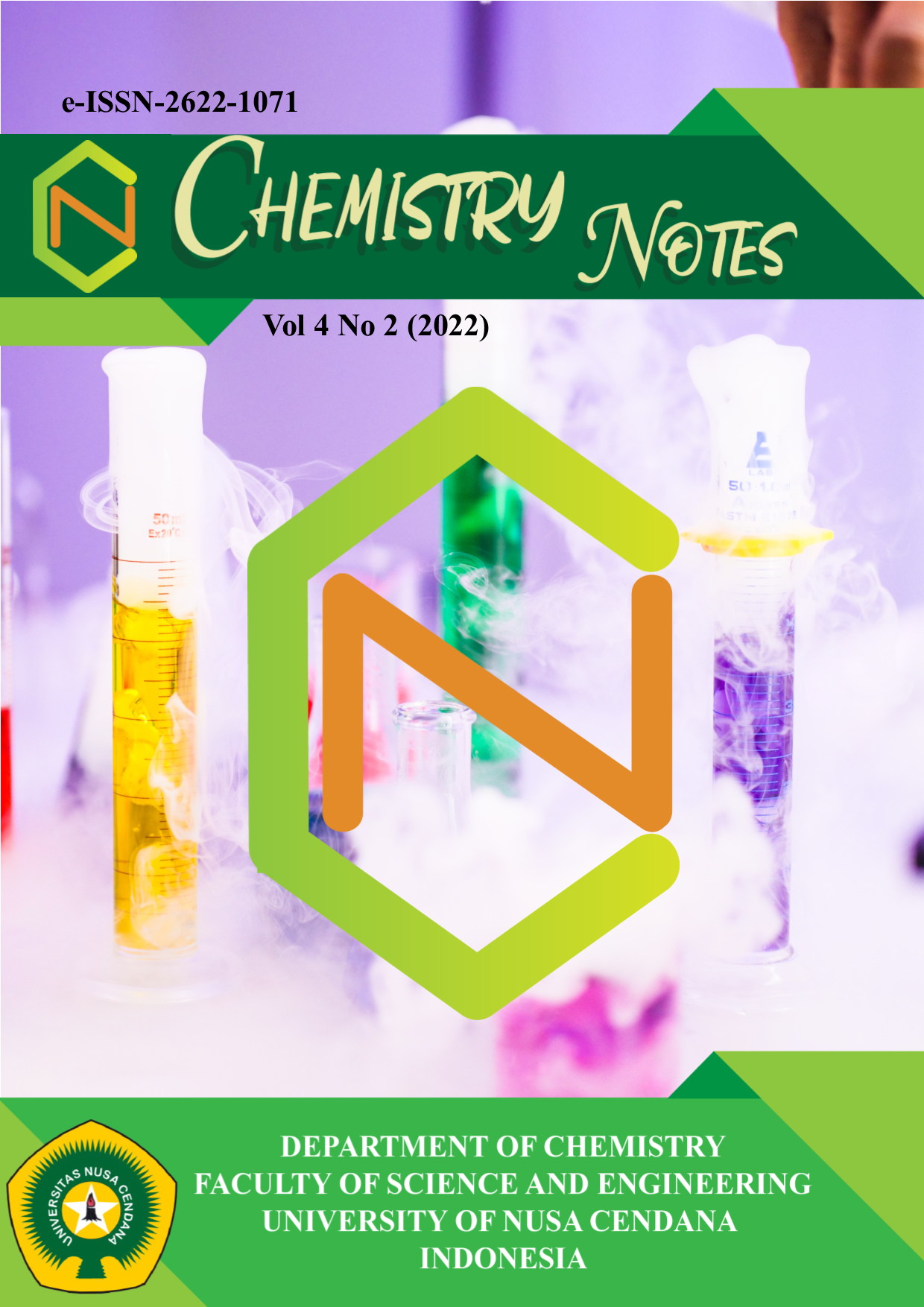Penurunan Kadar Kekeruhan, BOD, dan COD Pada Limbah Laundry Menggunakan Biosorben Arang Eceng Gondok (Eichhornia crassipes)
Abstract
Abstract
Research has been carried out with the title of reducing turbidity, BOD, and COD levels in laundry waste using water hyacinth charcoal biosorbent which aims to determine the surface area of water hyacinth charcoal biosorbent on reducing turbidity, BOD, and COD in laundry waste using water hyacinth charcoal biosorbent, knowing the effect of water hyacinth charcoal biosorbent contact time on decreasing turbidity, BOD, and COD in laundry waste, and knowing the effect of water hyacinth charcoal biosorbent on decreasing turbidity, BOD, and COD in laundry waste. The adsorbent used was water hyacinth (Eichhornia crassipes). Water hyacinth adsorbents is a plant used as a cleaning agent in waters polluted by heavy metals, reducing the movement of organic waste so asto to facilitate sedimention. The water hyacinth charcoal adsorbent functions as an adsorbent, where the adsorbents functions to control wastewater pollution. The adsorption used was water hyacinth (Eichhornia crassipes). Water hyacinth adsorbents in reducing turbidity, BOD, and COD are surface area, time variation and adsorbents mass. Final results the highest level of water hyacinth adsorbent surface area of 44.0754 m2 /g occurred at a contact time of 60 minutes. The final results of water hyacinth adsorbent contact time between laundry waste, the hihghest decrease in turbidity level of 47.52 % occurred in 30 minutes, the highest decrease in BOD contect of 80.04 % occurred in contact time of 60 minutes, and the highest decrease in COD was 38.70 % occurred at a contact time of 120 minutes. The final results of the water hyacinth adsorbent mass between laundry wastes, the highest decrease in turbidity content of 47.27 % occurred in 3 gram mass, the highest decrease in BOD contect was 80.04 % occurred in 6 gram mass, and the highest decrease in COD content was 37.02 % occurs at a mass of 12 gram.
Downloads
References
2. Ginting, Perdana. 2007. Sistem Pengolahan Lingkungan dan Limbah Industri. Bandung : Yrama Widya.
3. Ahmad, J, dan EI-Dessouky, H. 2008. Design of a modified low cost treatment system for the recycling and reuse of laundry waste water. Resources, conversation and Recycling, journal 52(1): 973-978
4. Wardhana, I,. dan Handayani, D. 2013. Penggunaan karbon aktif dari sampah plastik untuk menurunkan fosfat pada limbah cair laundry di semarang. Jurnal presipitasi :media komunikasi dan pengembangan teknik lingkungan 10(1): 30-40
5. Kusuma, D. A., Fitria, L., dan Kadaria, U. 2019. Pengolahan limbah laundry dengan metode moving bed biofilm reactor (MBBR).Jurnal teknologi lingkungan lahan basah. 2(1): 1-10. Tanjung pura
6. Adiastuti, F. E., Ratih, Y. W., dan Afany, M.R. 2018. Kajian pengolahan air limbah laundry dengan metode adsorpsi karbon aktif serta pengaruhnya terhadap pertumbuhan azolla. Jurnal tanah dan air.Vol 15(1):38-46.Yogyakarta
7. Santoso, D. R. 2016. Pemanfaatan Arang Aktif Limbah Kulit Ubi kayu Sebagai Bahan Adsorpsi Logam Besi (Fe) pada Air Sungai Purit Busuk di kecamatan Medan Perjuangan Sumatera Utara. Skripsi.Medan : Universitas Medan Area
8. Valentina, A. E., Miswadi, S.S., & Latifah. 2013. Pemanfaatan arang eceng gondok dalam menurunkan kekeruhan, COD, BOD pada air sumur. Indonesian journal of Chemical science, 2(2): 84-89
9. Rukmi, Dyah Puspito, Ellyke, R. S. Pujiati. 2013. The effectiveness of eichornia crassipes to decrease detergent, BOD, COD, Concentration in laundry wastewater. Jember : Fakultas kesehatan masyarakat, Universitas jember.
10. Novita E, Pradana HA, Wahyuningsih S, Hartaningsih ES (2019). Characterzation of laboratory wastewater for wastewater treatment plants used environmental biotechnology, Denpasar : international conference on sustainability science and management
11. Kasam, Yulianto, Andik : dan Sukma, Titin, 2005. Penurunan chemical oxygen demand dalam limbah cair laboratorium menggunakan filter karbon aktif arang tempurung kelapa, Jurusan Teknik Lingkungan FTSP UII, Jurnal logika, Vol.2 (2)
12. Day, R.A dan A.L.Underwood. 2011. Analisa Kimia Kuantitatif. Jakarta : Erlangga.
13. Goa. A., Gauru. I.,Solo. A., Mere. J. 2015. Pembuatan Filter Ganda Mangan-Zeolit dan Arang Aktif Tempurung Lontar Asal NTT Untuk Menurunkan Kadar Logam Fe dan Mn Dalam Limbah Cucian Mangan di Desa Noebesa Kabupaten Timor Tengah Selatan. Kupang : Jurusan Kimia, Fakultas Sains dan Teknik, Universitas Nusa Cendana.
14. Murdika, A. 2009. Aplikasi Teknik Kombinasi Adsorpsi dan Elektrolisis Untuk Menurunkan Kandungan Fenol dalam Limbah Industri Bahan Kimia Sanitasi. Skripsi. Jakarta : Jurusan Kimia Fakultas Matematika dan Ilmu Pengetahuan Alam Univesitas Indonesia.
15. Effendi, Hefni. 2013. Kualitas Air bagi pengelolaan sumber daya dan lingkungan perairan. Yogyakarta : Kanisius
16. Safrizal M.R. 2016. Pengaruh Biomassa Eceng Gondok dan Aerasi Terhadap Penurunan Konsentrasi Limbah Cair Pengolahan Kopi. Skripsi. Jember : Universitas Jember
17. Alaerts, G & Santika. 1987. Metode Penelitian Air. Surabaya : Usaha Nasional
18. Bayat, B. 2002. Journal of Hazardous Material, Vol. 95(3)275-290
In order to publish in Chemistry Notes, authors are required to agree to the copyright permission stating that the authors give the publisher the right to reproduce, display or distribute the accepted manuscript. In this agreement the authors also automatically declare that the submitted manuscript is exempted from plagiarism issue and conflict of interest among the authors.

 Mersi N. Ngana(1)
Mersi N. Ngana(1)





